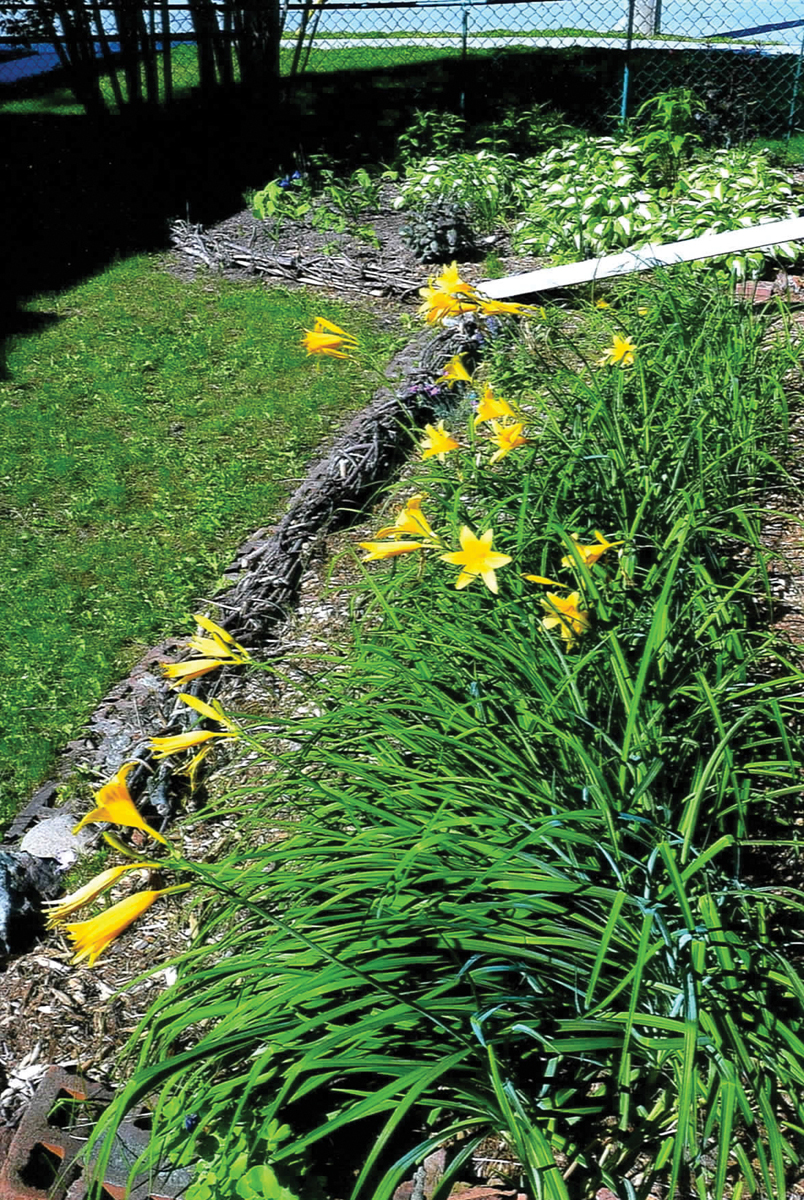by Louis Laframboise
About nine years ago, I took part in the restoration of Graham Creek, which is located in the west end of Ottawa, Ontario. The volunteers, including myself, were tasked with the job of building a fascine. (One of the pronunciations of this word “fascine” sounds like and rhymes with the word “machine.”) We took a bundle of sticks and brush, including dogwood and willow, tied it all together with string at regular intervals and then secured the bundle along the stream bank using wooden stakes.
At that time, I saw a lot of potential for these make-shift but sturdy bundles. Rather than burning saplings and pruned branches, or sending them to the compost pile where they take forever to decompose, or to noisy and smelly chippers, or to the landfill, they can be used on location in a wide range of applications. For example, they can be used to make discrete edges around garden plots or along paths and roadways.
 I have used wild grape vines to hold fascines together. These collections of branches and brush look beautiful wrapped in the vines. The final product is flexible and more sturdy. They can be woven, as it were, onto and into the landscape so they end up looking a bit like long snakes. I have used wild grape vines to hold fascines together. These collections of branches and brush look beautiful wrapped in the vines. The final product is flexible and more sturdy. They can be woven, as it were, onto and into the landscape so they end up looking a bit like long snakes.
The word “fascia” sounds somewhat similar to the word “fascine.” A fascia is a band of connective tissue under the skin in animals and humans. This tissue attaches, stabilises, encloses and separates muscles and other internal organs. The fascines work in a similar manner, stabilising the topsoil and delineating parts of the landscape. Just like bundles of fascia grouped together in the human body, fascines can be piled together or on top of each other, depending on the application.
 The beauty of fascines is that they are multifunctional. They can hold a garden bed or mulch in place. They slow down or prevent erosion. They allow water to soak into the ground and prevent topsoil from travelling downhill. They also define edges, increase diversity, create micro-environments, and provide habitats for insects and wild animals. They feed the mycelia and sequester carbon. They can also be used in check dams to slow water flow. There is no limit on how these fascines can be used. The beauty of fascines is that they are multifunctional. They can hold a garden bed or mulch in place. They slow down or prevent erosion. They allow water to soak into the ground and prevent topsoil from travelling downhill. They also define edges, increase diversity, create micro-environments, and provide habitats for insects and wild animals. They feed the mycelia and sequester carbon. They can also be used in check dams to slow water flow. There is no limit on how these fascines can be used.
On my land near Lanark, Ontario, I have used them to delineate paths and roadways, and I have placed them on contour to slow down water flow and catch organics. The more formal facines can be moved around once they are made. These long sausage-shaped bundles are usually staked in place.
Winter is a good time to work on assembling fascines, especially if your time is preoccupied with living plants during the green part of the year. There are lots of variations and you do not need to follow rules on how to make them. Group bundles of old or newly-cut logs, branches and twigs together–even weave them together if you can–and then use where needed. Wrapping each bundle with vines is optional, as is placing them on contour. Eventually they will all break down and become soil and humus.
Fascines also have a special aesthetic appeal. Unlike metal fences and linear divisions in the landscape, they provide a natural, flowing beauty and contribute to the integral sense of nature’s harmony and perfection. Instead of being an environmental problem, they become an artistic solution.
Because of their transcendent qualities, I see fascines both as ecojewels of the landscape and also as catchers of ecojewels, namely the silt, organic matter, soil, humus and water.
|


![]()

 I have used wild grape vines to hold fascines together. These collections of branches and brush look beautiful wrapped in the vines. The final product is flexible and more sturdy. They can be woven, as it were, onto and into the landscape so they end up looking a bit like long snakes.
I have used wild grape vines to hold fascines together. These collections of branches and brush look beautiful wrapped in the vines. The final product is flexible and more sturdy. They can be woven, as it were, onto and into the landscape so they end up looking a bit like long snakes.  The beauty of fascines is that they are multifunctional. They can hold a garden bed or mulch in place. They slow down or prevent erosion. They allow water to soak into the ground and prevent topsoil from travelling downhill. They also define edges, increase diversity, create micro-environments, and provide habitats for insects and wild animals. They feed the mycelia and sequester carbon. They can also be used in check dams to slow water flow. There is no limit on how these fascines can be used.
The beauty of fascines is that they are multifunctional. They can hold a garden bed or mulch in place. They slow down or prevent erosion. They allow water to soak into the ground and prevent topsoil from travelling downhill. They also define edges, increase diversity, create micro-environments, and provide habitats for insects and wild animals. They feed the mycelia and sequester carbon. They can also be used in check dams to slow water flow. There is no limit on how these fascines can be used.